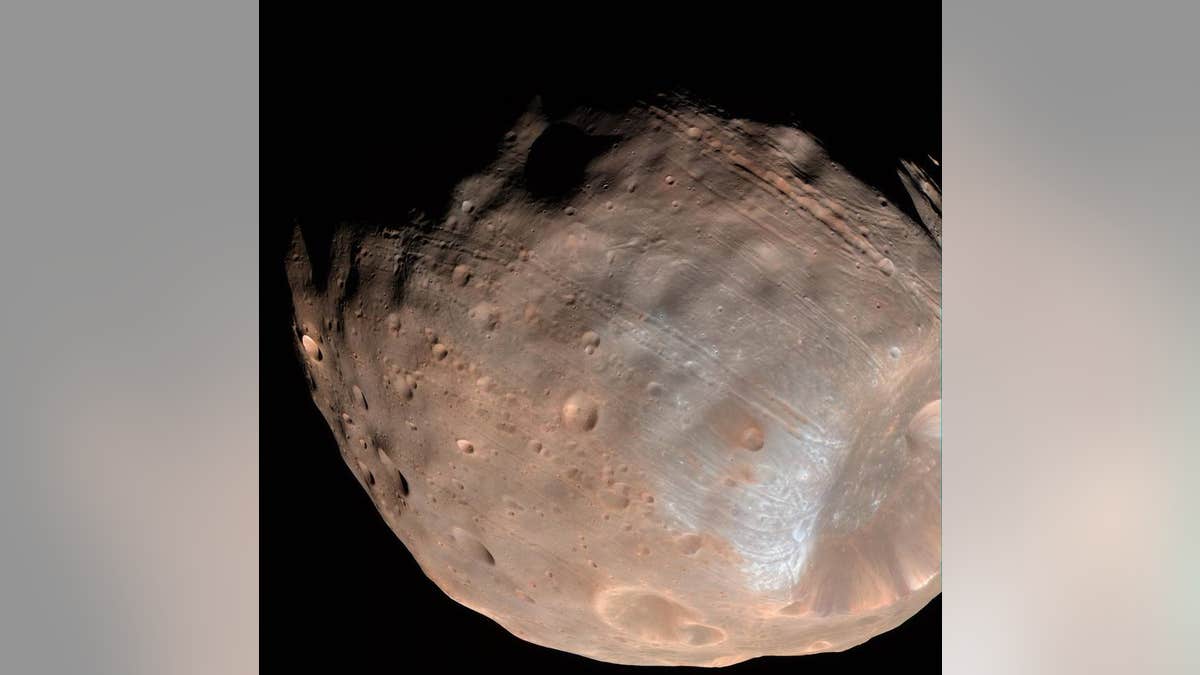
New modeling indicates that the grooves on Mars’ moon Phobos could be produced by tidal forces – the mutual gravitational pull of the planet and the moon. Initially, scientists had thought the grooves were created by the massive impact that made Stickney crater (lower right). (NASA/JPL-Caltech/University of Arizona)
It’s hard to miss the groove marks that crisscross the moon Phobos.
But rather than scars from a past encounter with an asteroid or another space object, NASA scientists believe they reflect the structural failure – much like cracks in the foundation of your home - of the larger of Mars' two moons. Ultimately, these spatial cracks will result in the destruction of Phobos.
“We think that Phobos has already started to fail, and the first sign of this failure is the production of these grooves,” said Terry Hurford of NASA’s Goddard Space Flight Center in Greenbelt, Maryland.
Related: Solar winds blamed for turning Mars into cold, barren place
Orbiting 3,700 miles above the surface of Mars, Phobos is closer to its planet than any other moon in the solar system. That is part of the problem. Mars’ gravity is drawing in Phobos by about 6.6 feet every hundred years.
Making things even worse for Phobos is a belief that its interior could be a rubble pile surrounded by a layer of powdery regolith. Not exactly a rock, solid moon.
But don’t worry; the demise of Phobos is some time away. Scientists expect the moon to be pulled apart in 30 to 50 million years.
Initially, scientists thought the grooves were created by the massive impact that made Stickney crater. That collision was so powerful, it came close to shattering Phobos. More recently, researchers thought the grooves were a result of material being ejected by Mars.
Related: Mars has flowing liquid water, NASA confirms
But new modeling by Hurford and colleagues supports the view that the grooves are more like “stretch marks” that occur when Phobos gets deformed by tidal forces. The gravitational pull between Mars and Phobos produces these tidal forces, similar to how Earth and our moon pull on each other and produce tides in the oceans.
The findings by Hurford and his colleagues are being presented this week at the annual Meeting of the Division of Planetary Sciences of the American Astronomical Society at National Harbor, Maryland.
Related: NASA confirms ancient lakes existed on Mars 2 to 3 billion years ago
“The funny thing about the result is that it shows Phobos has a kind of mildly cohesive outer fabric,” said Erik Asphaug of the School of Earth and Space Exploration at Arizona State University in Tempe and a co-investigator on the study. “This makes sense when you think about powdery materials in microgravity, but it's quite non-intuitive.”
The same fate may await Neptune’s moon Triton, which is also slowly falling inward and has a similarly fractured surface. The work also has implications for extrasolar planets, according to researchers.
“We can’t image those distant planets to see what’s going on, but this work can help us understand those systems, because any kind of planet falling into its host star could get torn apart in the same way,” Hurford said.
